
A glimpse of Dharmasena Pathiraja’s films
Nalaka Gunawardene and Vindana Ariyawansa
|
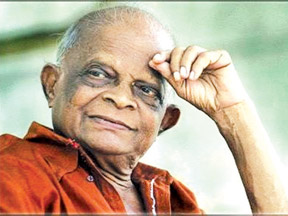
Premasiri Kemadasa
|
|
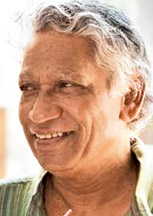
Dharmasena Pathiraja
|
Lankan film director Dharmasena Pathiraja has been called a rebel
with a cause: a socially conscious and engaged filmmaker who has
skillfully and creatively used his medium to tell stories addressing
current realities and issues.
If Lester James Peries was the pathfinder of an indigenous Sinhala
cinema that resonated with Sri Lanka’s political, social and cultural
revolution during the mid-1950s, Pathiraja has been a pioneer of the
Lankan cinema’s ‘second revolution’ that took off in the 1970s.
As Professor Wimal Dissanayake, a leading scholar of Asian cinema and
communication, noted: “He (Pathiraja), more than any filmmaker of his
time, succeeded in forging a very close alliance between cinema and the
public sphere in Sri Lanka.”
Today we start off with a few questions that offer us a glimpse of
the enduring cinematic legacy of this versatile filmmaker.
1. After trying his hand in short films for a few years, Dharmasena
Pathiraja made his first feature film in 1974. It tracks the life of a
group of unemployed friends who live in a working class flat and their
quest for the meaning of life. They ultimately turn to crime -- but not
before some insightful comments on the situation of youth looking for
direction. What was its title?
2. Directed by Dharmasena Pathiraja, this landmark Sinhala movie was
about stresses of life in a small, rural Lankan village. It earned
actress Malani Fonseka a special Diploma for female performance at the
8th Moscow International Film festival in 1978. This was for her lead
role in the movie as Susila. Incidentally, this was also the first
international award won by a Lankan actress. What was this film?
|
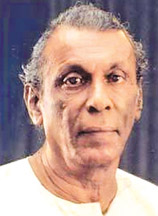
Joe Abeywickrama |
|
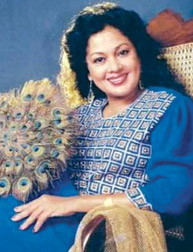
Malini Fonseka |
3. Udumbara Hina-henawa is a popular film song from a Sinhala film
directed by Dharmasena Pathiraja. Written by W Jayasiri with music was
composed by Premasiri Kemadasa, the song was sung by T M Jayaratne and
Ivor Dennis. In which Pathiraja movie was this song found?
4. Dharmasena Pathiraja was the first mainstream Sinhala film
director to direct a Tamil-language film in Sri Lanka. Titled Ponmani
(Younger Sister, 1978), the story was set in Jaffna and traced the
fortunes and concerns of an economically depleted upper caste, lower
middle class family. It was described as “an evocative film about land,
women, romance and tragedy, narrated in an idiom of understatement.” It
was based on a story by which Lankan writer in Tamil?
5. Another urban film that Pathiraja made was Paradige (On the Run,
1980) which he considers one of his favourites -- even though it was not
widely discussed by critics. He says it deals with “displacement but
without much sadness for that loss of rootedness”. The screenplay was
based on a short story by a fiction writer in Sinhala whom Pathiraja has
called “one of the greatest short story writers of our time”. Who wrote
the original story and was also involved in the screenplay of Paradige?
6. In 1981, this Dharmasiri Pathiraja feature film starring Joe
Abeywickrama, Malani Fonseka, Henry Jayasena and Daya Tennakone won the
Presidential Film Awards for Best Director and Best Screenplay. Out of
seven feature films he made from 1974 to 2001, this was the first
occasion where he wrote a screenplay for a movie. This 1981 movie
revolved around a retired old soldier and an ageing prostitute. What was
its name?
7. Name the popular American author and aviator - well known for his
inspirational writing - who said: “In order to live free and happily,
you must sacrifice boredom. It is not always an easy sacrifice.”
|
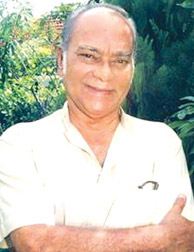
Henry Jayasena |
8. Who is she? University academic turned Parliamentarian, she was a
recent Prime Minister of New Zealand who served three successive terms
from 1999 to 2008. She then became the Administrator of the United
Nations Development Programme (UNDP) in April 2009, and is the first
woman to lead this major UN organization. She is also the Chair of the
United Nations Development Group, a committee consisting of the heads of
all UN funds, programmes and departments working on development issues.
|

A scene from Paradige (On the Run, 1980) |
9. Where in 1824 was the first tea plants brought from China were
planted in Sri Lanka, then Ceylon? It was a non-commercial planting done
for demonstration purposes. Commercial plantations in Ceylon did not
commence until 1867.
10. American athlete Jesse Owens won four gold medals at the 1936
Berlin Olympics, in 100 meters, 200 meters, long jump and 4x100 meters
relay. However, he nearly missed the finals of the long jump, because
his first two jumps were declared fouls. He was saved when someone
advised him to jump some distance before the official takeoff spot, so
that his jump would definitely be valid. The German athlete who gave
this friendly advice to Jesse Owens was seen as the ‘perfect Aryan’ by
the host Nazis, and later came second in the same event. He was the
first to congratulate Owens on the victory. Who was this German athlete?
11. In 1829, an American inventor and entrepreneur produced and
popularised the first wood and graphite pencil in the United States. At
the time, most people wrote with quill pens and ink. It was the American
Civil War (1861-65) that created a demand for a dry, clean, portable
writing instrument and suddenly, the humble pencil was in big demand.
This inventor came to Ceylon in 1838 to arrange for export of graphite
from the H L De Mel Company mines. The first Ceylon graphite traveled to
America as ballast in the early sailing vessels returning to New England
from Ceylon. Who was this populariser of the modern ‘lead’ pencil?
|
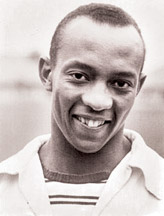
Jesse Owens |
12. Name the American statesman, founding father of the Union, man of
letters and twice the US President who once said, “Advertisements
contain the only truths to be relied on in a newspaper”.
13. Since the dawn of the Space Age in October 1957, many unmanned,
automatic space probes have been launched by space-faring nations. On 13
September 1959, a moon probe built and launched by the then Soviet Union
became the first human-made spacecraft to land on another celestial
body. The probe, weighting 390.2 kg (or 860.2 pounds), actually crashed
on to the Moon. What was its name?
14. The word ‘sadism’ was derived from Marquis de Sade and his life
(his later days in the asylum of Charenton) which was depicted in the
movie The Quills (2000) directed by Phillip Kaufman. It starred Kate
Winslet, Joaquine Phoenix Michael Caine and this Australian actor who
was nominated for Best Actor Oscar for playing Marquis de Sade. Who is
he?
15. This European city, the starting point of the 2010 Tour de
France, was once destroyed by German bombing during the Blitzkrieg. It
is one of the largest port cities in Europe, and only surpassed by the
port of Shanghai, China.
Although the biggest port city in Europe, it is not the economic
enter of the European Union. What is this city?
Last week’s answers
1. Henry King ‘Hank’ Ketcham (1920 - 2001)
2. Lee Falk (1911 - 1999)
3. “Chemical X”
4. Who Framed Roger Rabbit
5. Walter Benjamin Lantz (1899 - 1994)
6. Clifford R Dodd
7. Gusev
8. Mohideen Baig (1919 - 1991)
9. Kela Handa
10. Dharmasena Pathiraja
11. Q & A (2005)
12. Henry David Thoreau (1817 - 1862)
13. Boris Johnson
14. Ken Livingstone
15. Larisa Semyonovna Latynina |



